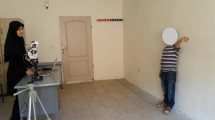Abstract
Helping behaviors are one of the important prosocial behaviors in order to develop social communication skills based on empathy. In this study, we examined the potentials of using a robot as a recipient of help, and helping behaviors to a robot. Also, we explored the relationships between helping behaviors and smiles that is an indicator of a positive mood. The results of this study showed that there might be a positive correlation between the amount of helping behaviors and the number of smiles. It implies that smiles may facilitate helping behaviors to the robot. This preliminary research indicates the potentials of robot-assisted interventions to facilitate and increase helping behaviors of children with Autism Spectrum Disorder (ASD).
Access this chapter
Tax calculation will be finalised at checkout
Purchases are for personal use only
Similar content being viewed by others
References
Broadbent, E.: Interactions with robots: the truths we reveal about ourselves. Annu. Rev. Psychol. 68(1), 627–652 (2017)
Huijnen, C.A.G.J., Lexis, M.A.S., Jansens, R., de Witte, L.: How to implement robots in interventions for children with autism? A co-creation study involving people with autism, parents and professionals. J. Autism Dev. Disord. 47(10), 3079–3096 (2017)
Diehl, J.J., Schmitt, L.M., Villano, M., Crowell, C.R.: The clinical use of robots for individuals with Autism Spectrum Disorders: a critical review. Res. Autism Spectrum Disord. 6(1), 249–262 (2012)
Ismail, L.I., Shamsudin, S., Yussof, H., Akhtar, F., Hanapiah, F.A., Zaharid, N.I.: Robot-based intervention program for autistic children with humanoid robot NAO: initial response in stereotyped behavior. Procedia Eng. 41, 1441–1447 (2012)
Bharatharaj, J., Huang, L., Mohan, R.E., Al-Jumaily, A., Krägeloh, C.: Robot-assisted therapy for learning and social interaction of children with Autism Spectrum Disorder. Robotics 6(1), 1–11 (2017)
American Psychiatric Association: Diagnostic and Statistical Manual of Mental Disorders (DSM-5), 5th edn. American Psychiatric Publishing, Arlington (2013)
Warren, Z.E., et al.: Can robotic interaction improve joint attention skills? J. Autism Dev. Disord. 45(11), 3726–3734 (2015)
Zheng, Z., Young, E.M., Swanson, A.R., Weitlauf, A.S., Warren, Z.E., Sarkar, N.: Robot-mediated imitation skill training for children with autism. IEEE Trans. Neural Syst. Rehabil. Eng. 24(6), 682–691 (2015)
Srinivasan, S.M., Eigst, I.-M., Gifford, T., Bhat, A.N.: The effects of embodied rhythm and robotic interventions on the spontaneous and responsive verbal communication skills of children with Autism Spectrum Disorder (ASD): a further outcome of a pilot randomized controlled trial. Res. Autism Spectrum Disord. 27, 54–72 (2016)
Warneken, F., Tomasello, M.: The roots of human altruism. Br. J. Psychol. 100(3), 455–471 (2009)
Bierhoff, H.W.: Altruism and patterns of social interaction. In: Staub, E., Bar-Tal, D., Karylowski, J., Reykowski, J. (eds.) Development and Maintenance of Prosocial Behavior, Critical Issues in Social Justice, vol. 31, pp. 309–321. Springer, Boston (1984). https://doi.org/10.1007/978-1-4613-2645-8_18
Svetlova, M., Nichols, S.R., Brownell, C.A.: Toddlers’ prosocial behavior: from instrumental to empathic to altruistic helping. Child Dev. 81(6), 1814–1827 (2010)
Warneken, F., Tomasello, M.: Varieties of altruism in children and chimpanzees. Trends Cogn. Sci. 13(9), 397–402 (2009)
Carlson, M., Charlin, V., Miller, N.: Positive mood and helping behavior: a test of six hypotheses. J. Pers. Soc. Psychol. 55(2), 211–229 (1988)
Baron, R.: The sweet smell of... helping: effects of pleasant ambient fragrance on prosocial behavior in shopping malls. Pers. Soc. Psychol. Bull. 23(5), 498–503 (1997)
Cunningham, M.: Weather, mood, and helping behavior: quasi experiments with the sunshine samaritan. J. Pers. Soc. Psychol. 37(11), 1947–1956 (1979)
Guéguen, N., de Gail, M.: The effect of smiling on helping behavior: smiling and good Samaritan behavior. Commun. Rep. 16(2), 133–140 (2003)
Goldman, M., Fordyce, J.: Prosocial behavior as affected by eye contact, touch, and voice expression. J. Soc. Psychol. 121(1), 125–129 (1983)
Salovey, P., Mayer, J.D.: Emotional intelligence. Imagination, Cogn. Pers. 9, 185–211 (1990)
Messinger, D.S., Cassel, T.D., Acosta, S.I.: Infant smiling dynamics and perceived positive emotion. J. Nonverbal Behav. 32(3), 133–155 (2008)
Frank, M.G., Ekman, P., Friesen, W.V.: Behavioral markers and the recognizability of the smile of enjoyment. J. Pers. Soc. Psychol. 64(1), 83–93 (1993)
Ekman, P., Davidson, R.J., Friesen, W.V.: The Duchenne smile: emotional expression and brain physiology II. J. Pers. Soc. Psychol. 58(2), 342–353 (1990)
Vrugt, A., Vet, C.: Effects of a smile on mood and helping behavior. Soc. Behav. Pers.: Int. J. 37(9), 1251–1258 (2009)
Li, X., Meng, X., Li, H., Yang, J., Yuan, J.: The impact of mood on empathy for pain: evidence from an EEG study. Psychophysiology 54(9), 1311–1322 (2017)
Funahashi, A., Gruebler, A., Aoki, T., Kadone, H., Suzuki, K.: Brief report: the smiles of a child with Autism Spectrum Disorder during an animal-assisted activity may facilitate social positive behaviors - quantitative analysis with smile-detecting interface. J. Autism Dev. Disord. 44(3), 685–693 (2014)
O’Haire, M.E., McKenzie, S.J., Beck, A.M., Slaughter, V.: Social behaviors increase in children with autism in the presence of animals compared to toys. PLoS ONE 8(2), e57010 (2013)
Grandgeorge, M., Tordjman, S., Lazartigues, A., Lemonnier, E., Deleau, M., Hausberger, M.: Does pet arrival trigger prosocial behaviors in individuals with autism? PLoS ONE 7(8), e41739 (2012)
Hirokawa, M., Funahashi, A., Itoh, Y., Suzuki, K.: Adaptive behavior acquisition of a robot based on affective feedback and improvised teleoperation. IEEE Trans. Cogn. Dev. Syst. 54(9) (in press)
Gruebler, A., Suzuki, K.: Design of a wearable device for reading positive expressions from facial EMG signals. IEEE Trans. Affect. Comput. 5(3), 227–237 (2014)
Author information
Authors and Affiliations
Corresponding author
Editor information
Editors and Affiliations
Rights and permissions
Copyright information
© 2018 Springer Nature Switzerland AG
About this paper
Cite this paper
Kim, S., Hirokawa, M., Matsuda, S., Funahashi, A., Suzuki, K. (2018). Smiles of Children with ASD May Facilitate Helping Behaviors to the Robot. In: Ge, S., et al. Social Robotics. ICSR 2018. Lecture Notes in Computer Science(), vol 11357. Springer, Cham. https://doi.org/10.1007/978-3-030-05204-1_6
Download citation
DOI: https://doi.org/10.1007/978-3-030-05204-1_6
Published:
Publisher Name: Springer, Cham
Print ISBN: 978-3-030-05203-4
Online ISBN: 978-3-030-05204-1
eBook Packages: Computer ScienceComputer Science (R0)




